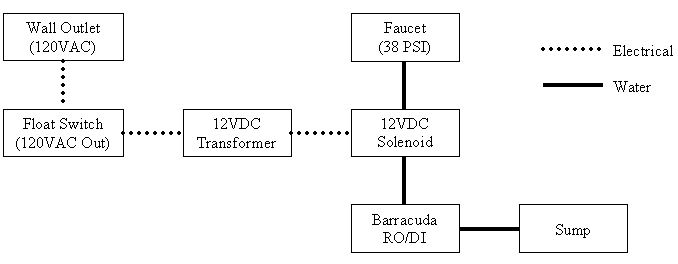

Bulletin board/Tableau d'affichage | Survey | Store | Chat | Library | Merchandise | Tell A Friend
The library contains informative articles about reef keeping. If you are interested in contributing, send your draft to support@canreef.com
Aqua FX Barracuda 100 GPD 4 Stage RO/DI Review
by Titus Cheung, Canreef Aquatics Ltd. Jul 2002
|
In Spring 2002, Marianne Brizio, president of the water filtration company
Aqua FX sent
me an e-mail about sponsoring our online
forum. At that time it was
an attractive offer since one of our photo contest sponsors had been having difficulties
dealing with his company's previous partners, and therefore was unable to deliver prizes
on time. As a result, I proposed to Aqua FX that they send us first a sample of their RO/DI unit
so we can perform a review and they agreed.
The unit that Aqua FX sent was their most popular
Barracuda 4 Stage RO/DI unit. It was sent via US Airborne Express so it was only an
overnight shipment to Canada. And since this was going to be a review, attention to details
was surely one of items on the checklist. One notable feature with the shipment was the
packaging methodology used. To many experienced aquarist, it is not un-common to see many
products from high end manufacturers (except the very few) shipped in simple containers,
The next thing that I notice is the nice manuals and product brochures that Aqua FX supplies. Unlike the typical home made photocopies typically supplied with the usual skimmer and test kits, these are high quality color prints on nice glossy paper. The instructions and diagrams were logically laid out. 5 minutes after reading the manual, the complete unit was setup ready to go. Normally customers have the option of indicating whether they will plumb the unit to a regular facuet or a garden hose type. Unfortunately I have forgotten to tell Aqua FX that I need a facuet adaptor and a garden hose connector was supplied instead. However, this is an easy problem as I was able to find one from a local aquarium supplier. The unit also came with essential tool such as the canister wrench, and lots and lots of color coded tubes. Unlike skimmers or calcium reactors, there are no bubble size, internal water level, feed rate, and/or drip rate to adjust on a RO/DI unit. So I decided to try something new and different. One common problem with the maintenance of a reef system is the constant need to maintain salinity level, which changes due to evaporation. For system under high level of Metal Halide lights, and the use of fans to promote evaporation in order to control water temperature, salinity can rise rapidly. Constant fresh water top off is therefore a necessary task in order to control the salinity and temperature swing of the system. However, regardless of how much time the system keeper commits, there is no way to know when to top off until much water has been evaporated, or until water level in the sump has dropped in a visually recognizable manner. As such, the thought of a completely automated top off system came across. Afterall, the test sytem was setup to top off automatically from a reservoir filled with fresh water, which was filtered by the ubiquitous Tap Water Purifier, a carbon/de-ionizing filter. However, the reservoir only has a limited supply and can not last forever, and overflows and wet floors are common problems during the reservoir refill process. Further, the test system has practically everything automated. This includes the feeding, lighting, photo period, calcium/alkalinity control with a calcium reactor, and fan control. This was setup due to the fact that I had to be away from time to time for a period of months. Usually the reservoir will get almost empty by the time I return. Motivated by the above, a new auto top off system was implemented. The Barracuda RO/DI unit supplied by Aqua FX was attached permenantly to the faucet, through a stainless steel solenoid, powered by a DC transformer attached to the orignal float switch from the previous setup. The setup is illustrated in the following diagram. |
||||||
 System Diagram |
||||||
The actual components are shown below:
|
||||||
|